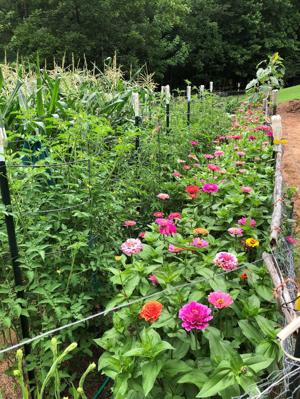
by Mike Lloyd
Cherokee Tribune
Just about everyone, worldwide, will probably agree that 2020 has been a very unusual year. COVID-19 has dramatically affected our lifestyle – in most cases, negatively, but there have been a few positive impacts. On the brighter side, more people have planted gardens. Most of these gardens are vegetable gardens motivated to being more self-reliant, food-wise. Besides the benefit of harvesting our own fresh food, this trend has had the benefit of getting people outside and exercising; the gardens have also given those who have chosen to start one, a sense of purpose, and, hopefully, the satisfaction of fresh homegrown food.
Although growing our food has its health benefits, we shouldn’t forget to grow flowers as well as food crops in our gardens. In fact, flowers should be an integral part of every vegetable garden. There are many reasons for growing flowers in our vegetable gardens:
1. Flowers add beauty to any garden. This is the most obvious reason to grow flowers. Early on, most vegetables are attractive looking, but, as they age, they tend to become a bit ungainly and, perhaps, downright ugly. It’s difficult for me to think a tomato plant is a thing of beauty in the late season. Flowers planted along the edges help improve the overall appearance of a vegetable garden. This is especially important if you have neighbors in close proximity. Zinnias make a particularly nice border for my vegetable garden (see photo); they have a side benefit of attracting butterflies, songbirds, and hummingbirds to my property.
2. Flowers attract pollinators to the garden. This is very important because most vegetable and fruit crops need pollination by insects to set fruit. The insects, which include honeybees, mason bees, other native bees, wasps, and even the oft-dreaded carpenter bees. These insects will improve the quantity and quality of your fruit and vegetable produce.
3. Flowers can help manage weeds. Some flowers serve as ground covers that not only shade the soil below their foliage but also serve to slow erosion of soft garden soil. Nasturtiums and alyssums serve this purpose well.
4. Flowers can improve soil fertility. Legumes, such as peas, beans, alfalfa, and clover, are among these plants, their roots fix nitrogen into the soil. Planting legumes in areas of the garden that are not in active food production (e.g., before or after the vegetable crop) and turning the plants under the soil will add nutrients (especially, nitrogen) and organic matter to the soil.
5. Flowers can serve as a way to manage pests. Marigolds should be part of every garden. Their roots appear to attract and kill nematodes; thus, they can help reduce the number of these pests in the soil near them.
6. Flowers can be edible. The flowers of many plants typically grown for their ornamental value are edible. Among these are the nasturtium, marigold, pansy, rose, calendula, daylily, lavender, hibiscus, gladiolus, hyssop, and borage. There are many others. The leaves or roots of some typically ornamental plants can also be eaten. However, care should be taken to avoid potentially poisonous plants; among these are daffodil, poppy, and larkspur, but there are many others.
7. Flowers add biodiversity to the garden. Biodiversity is important, because it increases the potential for supporting beneficial insects and pollinators. This is true on all scales, from a large farm to a small backyard garden. So, planting a wide variety of plants, including flowers, is a good thing for everyone.
Just like vegetables, some considerations should be made in growing flowers. Among these considerations are the bloom time, height, and spacing.
As far as bloom time goes, the idea is to have something blooming from early Spring to late Fall. For example, sweet peas will provide an early bloom but will fade as temperatures rise. Marigolds and zinnias can pick up the slack by blooming during the warmer months of the growing season,
well into the Fall.
well into the Fall.
Regarding flower height, it is advisable to plant taller flowers, such as sunflowers, on the north side of your garden, so that they won’t shade the vegetable plants.
It is also a good idea to plant the flowering plants so that their beauty can be seen by both the gardener and the pollinator. One way to do this is by planting flowers in a swath of the garden, like the row or zinnias in the photo. Another way is to place the flowers in amongst the vegetables.
Their proximity not only creates a little beauty spot in the garden but should also optimize their beneficial impacts on the nearby vegetable plants. I put nasturtiums and marigolds at the end of my vegetable rows.
Regardless of what you’re growing, you should do a little research as to whether what you want to grow is suited to our area. You should ask other gardeners, especially those who have been gardening for a few years, for suggestions and advice both prior to and during the growing season. And remember, that you can always direct questions to your local UGA Extension representative and your local Master Gardener friends.
